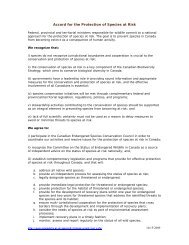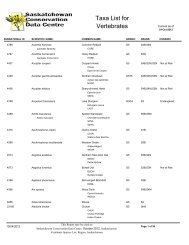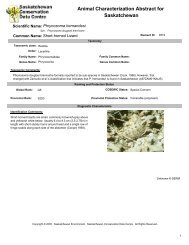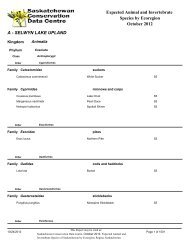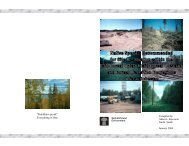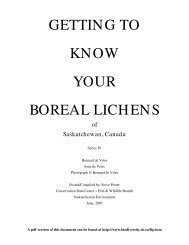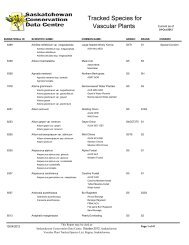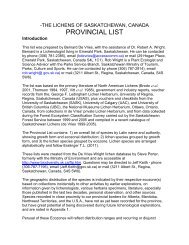Terrestrial Field Surveys - Saskatchewan Conservation Data Centre
Terrestrial Field Surveys - Saskatchewan Conservation Data Centre
Terrestrial Field Surveys - Saskatchewan Conservation Data Centre
You also want an ePaper? Increase the reach of your titles
YUMPU automatically turns print PDFs into web optimized ePapers that Google loves.
Fauna (continued)<br />
<strong>Saskatchewan</strong><br />
3211 Albert Street<br />
Regina, Canada<br />
S4S 5W6<br />
An updated list of Species at Risk that occur in <strong>Saskatchewan</strong> can be found on the CDC website<br />
http://www.biodiversity.sk.ca/Docs/SpeciesAtRiskinSK.pdf. Please note that this list does not<br />
include all of the S1-S3 species ranked by the CDC, which should still be identified in survey<br />
efforts.<br />
To generate both a species list for the impacted area as well as their relative numbers, we<br />
recommend using systematic, standardized point count surveys along line transects. For species<br />
such as Burrowing Owls that may be in an area, their presence can be confirmed by meandering<br />
searches and inspecting roost and nest burrows (e.g.: pellets, feathers, whitewash), or by using<br />
call playback surveys (Note that a Scientific Research Permit is required for this). It is essential<br />
that only qualified persons inventory wildlife that may be in the project area.<br />
All breeding bird surveys must be done during the appropriate times of the year (mid May – 1 st<br />
week in July for songbirds) and day (up to 4 hours after sunrise for diurnal species; from 2 hours<br />
before sunset for crepuscular/nocturnal species), and only during acceptable weather conditions<br />
(see Table 1). <strong>Surveys</strong> should be done twice during the breeding season, at least 2 weeks apart.<br />
Amphibians are also most easily detected using auditory point counts and by conducting visual<br />
surveys for adults and larvae in appropriate habitats. We suggest following the North American<br />
Amphibian Monitoring Protocol guidelines for surveying frogs in <strong>Saskatchewan</strong> (USGS, 2005;<br />
found online at: http://www.pwrc.usgs.gov/naamp/index.cfm?fuseaction=app.protocol. In general,<br />
a biologist will listen for 5 minutes at all wetlands or potential habitats in the project area, and<br />
place their survey points ~ 500 m - 800 m apart. The best time to survey is after a rainfall, and<br />
approximately 30 minutes after sunset or in the evening. At each survey station, biologists will<br />
record an amphibian calling index for each species heard (e.g.: individuals can be distinguished<br />
vs. constant chorus). Surveyors are also pointed to pay particular attention paid to the appropriate<br />
weather conditions for conducting these surveys (sky, wind and noise index).<br />
Proponents must also identify any migratory staging areas for birds that may be impacted by the<br />
development; consider proximity and noise levels when determining if an area may be impacted<br />
(i.e.: survey the areas surrounding the development).<br />
Activity restriction guidelines have been identified for many sensitive taxa and can be found on<br />
the CDC website at: http://www.biodiversity.sk.ca/Docs/SKactivityrestrictions.pdf. These buffer<br />
zones should be respected when conducting surveys. If they must be breached, a Scientific<br />
Research Permit may be required.<br />
3



